木材学双语教案-第2章
- 格式:ppt
- 大小:1.81 MB
- 文档页数:3
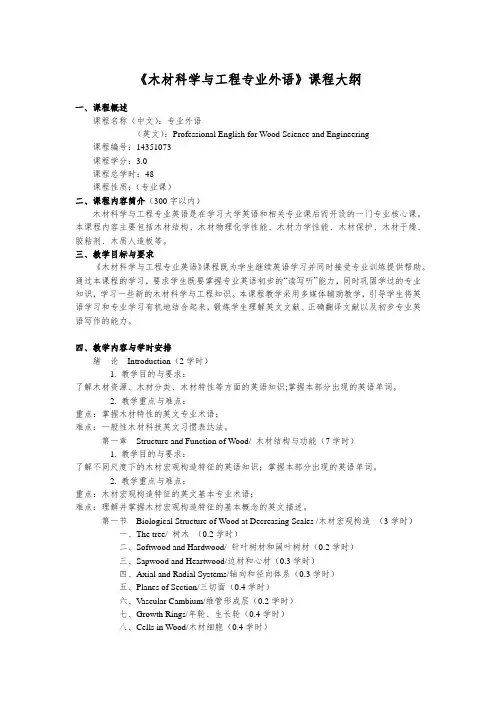
《木材科学与工程专业外语》课程大纲一、课程概述课程名称(中文):专业外语(英文):Professional English for Wood Science and Engineering 课程编号:14351073课程学分:3.0课程总学时:48课程性质:(专业课)二、课程内容简介(300字以内)木材科学与工程专业英语是在学习大学英语和相关专业课后而开设的一门专业核心课。
本课程内容主要包括木材结构、木材物理化学性能、木材力学性能、木材保护、木材干燥、胶粘剂、木质人造板等。
三、教学目标与要求《木材科学与工程专业英语》课程既为学生继续英语学习并同时接受专业训练提供帮助。
通过本课程的学习,要求学生既要掌握专业英语初步的“读写听”能力,同时巩固学过的专业知识,学习一些新的木材科学与工程知识。
本课程教学采用多媒体辅助教学,引导学生将英语学习和专业学习有机地结合起来,锻炼学生理解英文文献、正确翻译文献以及初步专业英语写作的能力。
四、教学内容与学时安排绪论Introduction(2学时)1. 教学目的与要求:了解木材资源、木材分类、木材特性等方面的英语知识;掌握本部分出现的英语单词。
2. 教学重点与难点:重点:掌握木材特性的英文专业术语;难点:一般性木材科技英文习惯表达法。
第一章Structure and Function of Wood/ 木材结构与功能(7学时)1. 教学目的与要求:了解不同尺度下的木材宏观构造特征的英语知识;掌握本部分出现的英语单词。
2. 教学重点与难点:重点:木材宏观构造特征的英文基本专业术语;难点:理解并掌握木材宏观构造特征的基本概念的英文描述。
第一节Biological Structure of Wood at Decreasing Scales /木材宏观构造(3学时)一、The tree/ 树木(0.2学时)二、Softwood and Hardwood/ 针叶树材和阔叶树材(0.2学时)三、Sapwood and Heartwood/边材和心材(0.3学时)四、Axial and Radial Systems/轴向和径向体系(0.3学时)五、Planes of Section/三切面(0.4学时)六、Vascular Cambium/维管形成层(0.2学时)七、Growth Rings/年轮、生长轮(0.4学时)八、Cells in Wood/木材细胞(0.4学时)九、Cell walls/细胞壁(0.4学时)十、Pits/纹孔(0.2学时)第二节Microscopic Structure of Softwoods and Hardwoods/针叶树材和阔叶树材微观构造(2学时)一、Softwoods/ 针叶树材(1学时)(一)Tracheids/管胞(0.3学时)(二)Axial Parenchyma and Resin Canal Complexes/轴向薄壁组织和树脂道(0.4学时)(三)Rays/木射线(0.3学时)二、Hardwoods/ 阔叶树材(1学时)(一)Vessels/导管(0.3学时)(二)Fibers /木纤维(0.2学时)(三)Axial Parenchyma/轴向薄壁组织(0.2学时)(四)Rays/木射线(0.2学时)第三节Juvenile Wood and Reaction Wood/幼龄材和应力木(1学时)一、Juvenile Wood/ 幼龄材(0.5学时)二、Reaction Wood/ 应力木(0.5学时)第四节The Properties of Wood Valuable in Identification /对木材识别有价值的木材物理性质(1学时)一、Color / 材色(0.2学时)二、Luster / 光泽(0.2学时)三、Grain and Texture/纹理和结构(0.4学时)四、Odor and taste / 木材的气味和滋味(0.2学时)第二章Chemical components of wood / 木材化学组成(2学时)1. 教学目的与要求:掌握木材化学成分的组成、定义。
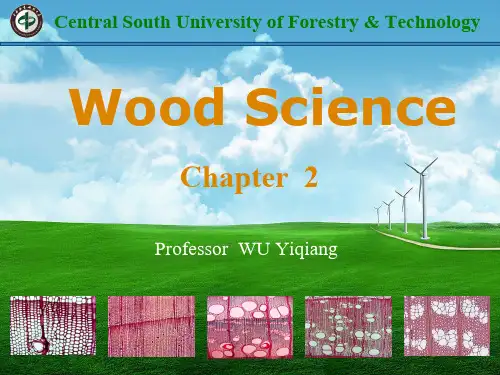
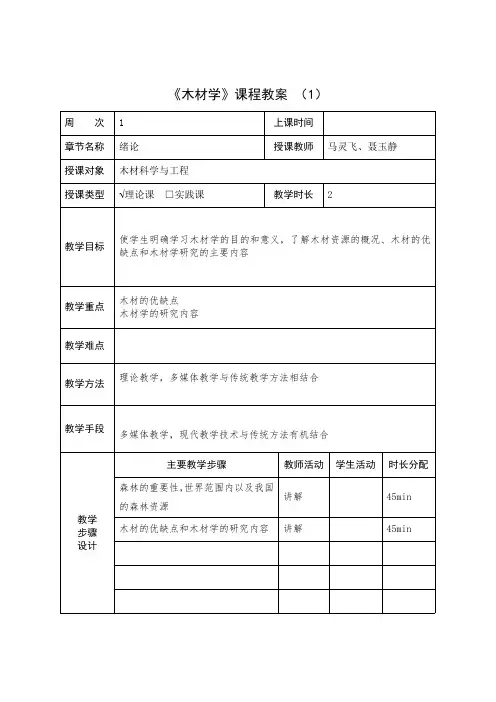
《木材学》课程教案(1)周次1上课时间章节名称绪论授课教师马灵飞、聂玉静授课对象木材科学与工程授课类型√理论课□实践课教学时长2教学目标使学生明确学习木材学的目的和意义,了解木材资源的概况、木材的优缺点和木材学研究的主要内容教学重点木材的优缺点木材学的研究内容教学难点教学方法理论教学,多媒体教学与传统教学方法相结合教学手段多媒体教学,现代教学技术与传统方法有机结合教学步骤设计主要教学步骤教师活动学生活动时长分配森林的重要性,世界范围内以及我国的森林资源讲解45min木材的优缺点和木材学的研究内容讲解45min教学内容一、森林的重要性,世界范围内以及我国的森林资源1.森林的重要性生态功能;提供木材等。
2.世界范围内的森林资源4.我国森林资源培育上的问题国家经济建设中,木材与钢材、水泥、塑料并列为四大建设材料。
(1)建筑用材;(2)采掘用材;(3)交通建设用材;(4)造纸用材;(5)家具用材;(6)农用材;(7)其它:如火柴材、乐器用材、运动器械用材、工艺美术用材等。
二.木材的优缺点1、木材的优点易于加工,加工所需能量较低,不易污染环境;木材质轻而强度高;气干木材是良好的热绝缘和电绝缘材料;木材有吸收能量的作用;木材在破坏前有预兆;木材有天然的美丽的花纹、光泽和颜色,有特殊的装饰效果。
2、木材的缺点干缩湿胀;木材容易腐朽和被虫蛀;小尺寸木材易于燃烧;木材的性质各向异性;具有天然缺陷。
三.木材学的研究内容国际木材科学学会(IAWS)确定了广义的木材科学:指木质化天然材料及其制品的生物学、化学和物理性质,以及生产、加工工艺的科学依据。
木材科学的狭义范畴是以木材为对象的材料科学,为基础学科,包括木材结构,木材性质(化学、物理、力学),木材缺陷和木材的功能性改良理论等内容。
讨论练习作业1.木材的优缺点有哪些?2.我国森林资源存在的问题有哪些?教具准备教学参考资料教材:《木材学》,刘一星、赵广杰编著,中国林业出版社,2012年。
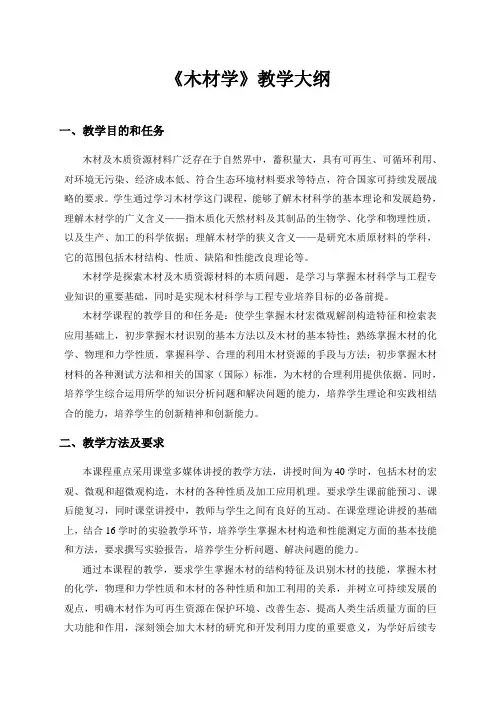
《木材学》教学大纲一、教学目的和任务木材及木质资源材料广泛存在于自然界中,蓄积量大,具有可再生、可循环利用、对环境无污染、经济成本低、符合生态环境材料要求等特点,符合国家可持续发展战略的要求。
学生通过学习木材学这门课程,能够了解木材科学的基本理论和发展趋势,理解木材学的广义含义——指木质化天然材料及其制品的生物学、化学和物理性质,以及生产、加工的科学依据;理解木材学的狭义含义——是研究木质原材料的学科,它的范围包括木材结构、性质、缺陷和性能改良理论等。
木材学是探索木材及木质资源材料的本质问题,是学习与掌握木材科学与工程专业知识的重要基础,同时是实现木材科学与工程专业培养目标的必备前提。
木材学课程的教学目的和任务是:使学生掌握木材宏微观解剖构造特征和检索表应用基础上,初步掌握木材识别的基本方法以及木材的基本特性;熟练掌握木材的化学、物理和力学性质,掌握科学、合理的利用木材资源的手段与方法;初步掌握木材材料的各种测试方法和相关的国家(国际)标准,为木材的合理利用提供依据。
同时,培养学生综合运用所学的知识分析问题和解决问题的能力,培养学生理论和实践相结合的能力,培养学生的创新精神和创新能力。
二、教学方法及要求本课程重点采用课堂多媒体讲授的教学方法,讲授时间为40学时,包括木材的宏观、微观和超微观构造,木材的各种性质及加工应用机理。
要求学生课前能预习、课后能复习,同时课堂讲授中,教师与学生之间有良好的互动。
在课堂理论讲授的基础上,结合16学时的实验教学环节,培养学生掌握木材构造和性能测定方面的基本技能和方法,要求撰写实验报告,培养学生分析问题、解决问题的能力。
通过本课程的教学,要求学生掌握木材的结构特征及识别木材的技能,掌握木材的化学,物理和力学性质和木材的各种性质和加工利用的关系,并树立可持续发展的观点,明确木材作为可再生资源在保护环境、改善生态、提高人类生活质量方面的巨大功能和作用,深刻领会加大木材的研究和开发利用力度的重要意义,为学好后续专业课程奠定必要的理论基础。

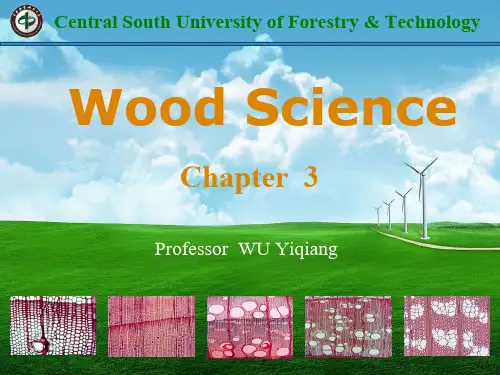
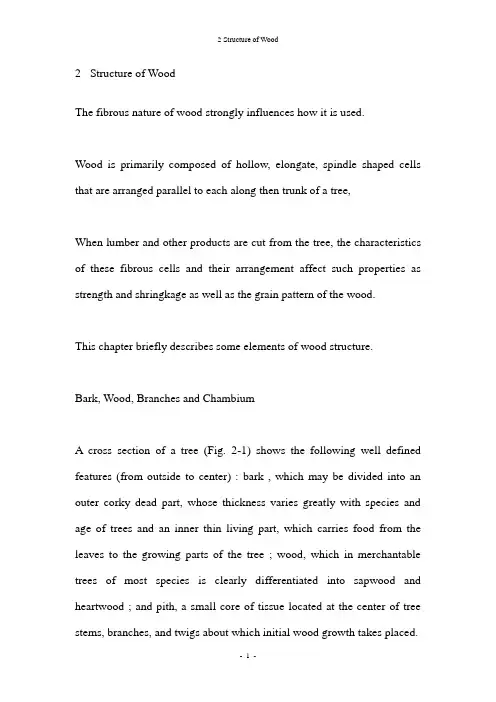
2Structure of WoodThe fibrous nature of wood strongly influences how it is used.Wood is primarily composed of hollow, elongate, spindle shaped cells that are arranged parallel to each along then trunk of a tree,When lumber and other products are cut from the tree, the characteristics of these fibrous cells and their arrangement affect such properties as strength and shringkage as well as the grain pattern of the wood.This chapter briefly describes some elements of wood structure.Bark, Wood, Branches and ChambiumA cross section of a tree (Fig. 2-1) shows the following well defined features (from outside to center) : bark , which may be divided into an outer corky dead part, whose thickness varies greatly with species and age of trees and an inner thin living part, which carries food from the leaves to the growing parts of the tree ; wood, which in merchantable trees of most species is clearly differentiated into sapwood and heartwood ; and pith, a small core of tissue located at the center of tree stems, branches, and twigs about which initial wood growth takes placed.Sapwood contains both living and dead tissue and carries sap from the roots to the leaves.Heartwood is formed by a gradual change in the sapwood and is inactive,The wood rays, horizontally oriented tissue through the radial plane of the tree, vary in size from one cell wide and a few cell high to more than 15 cells wide and several centimeters high.The rays connected various layers from pith to bark and forms wood and bark cells, can be seen only with a microscopel.As thr tree grows in height, branching is initiated by lateral bud development.The lateral branches are intergrown with the wood of the trunk as long as they are alive.After a branch dies, the trunk continues to increase in diameter and surrounds that portion of the branch projecting from the trunk when the branch died.If the dead branches drop from the tree, the dead stubs become overgrown and clear wood is formedSapwood and HeartwoodSapwood is located between the cambium and heartwood (Fif.2-1).Sapwood contains both living and dead cells and functions primarily in the storage of food ; in the outer layers near the cambium, sapwood handles the transpor of water or sap.The sapwood may vary in thickness and number of growth rings.Sapwood commonly ranges from 4 to 6 cm in radial thickness.As a rule , the more vigorously growing trees have wider sapwood.In general, heartwood consists of inactive cells that do not function in either water condition or food storage.The transition from sapwood to heartwood is accompanied by an increase in extractive content.Frequently, these extractives darken the heartwood and give species such as black walnut and cherry their characteristic color.Lighter colored heartwood occurs in some species.Heartwood extractives may also affect wood by (a) reducing permeability, making the heartwood slower to dry and more difficult to impregnate with chemical preservatives, (b) increasing stability in changing moisture conditions, and (c) increasing weight (slightly).Growth RingsIn most apecies in temperate climates, the difference between wood that is formed early in a growing rings (Fig.2-1).However, if the growth in diameter is interrupted, by drought or defoliation by insects for example, more than one ring may be formed in the same season,In such an event, the inner rings usually do not have sharply defined boundaries and are termed fasle rings,Trees that have only very small crowns or that have accidentally lost most of their foliage may form an incomplete growth layer, sometimes called a discontinuous ring.Growth rings are most readily seen in species with sharp contrast between latewood formed in one year and earlywood formed in the following year, such as in the native ring porous hardwoods ash and oak, and in softwoods like southern pines.In some other species, such as water tupelo, aspen, and sweet gum, differentiation of earlywood and latewood is slight and the annual growth rings are difficult to recognize.In many tropical regions, growth may be practically continuous throughout the year, and no well defined growth rings are formed.Wood CellsWood cells-----the structural elements of the wood tissue----are of varioussizes and ahapes and quite firmly cemented together.Dry wood cells may be empty or partly filled with deposits, such as gums and resins.The majority of wood cells are considerably elongated and pointed at the ends; these cells are customarily called fibers or tracheids.The length of wood fibers is highly variable within a tree and among species.Hardwood fibers average about 1 mm in length; softwood fibers range from 3 to 8 mm in length.In addition to fibers, hardwoods have cells of relatively large diameter known as vessels or pores.Both hardwoods and softwoods have cells (usually grouped into structures or tissues) that are oriented horizontally in the direction from pith toward bark.These groups of cells conduct sap radially across the grain and are calledrays or wood rays.The rays are most easily seen on edge grained or quartersaw surface, and they vary greatly in size in different species.Chemical CompositionDry wood is primarily composed of cellulose, lignin, hemicelluloses, and minor amounts (5% to 10%) of extraneous materials.Cellulose, the major component, constitutes approximately 50% of wood substance by weight.It is a high –molecular-weight linear polymer consisting of chains of 1 to more than 4 –linked glucose monomers.Lignin constitutes 23% to 33% of the wood substance in softwoods and 16% to 25% in hardwoods.Although lignin occurs in wood throughout the cell wall, it is concentrated toward the outside of the cells and between cells.Lignin is often called the cementing agent that binds individual cells together.The hemicelluloses are associated with cellulose and are branched, low-molecular-weight polymers composed of several different kinds of pentose and hexose sugar monomers.The relative amounts of these sugars vary markedly with species.Hemicelluloses play an important role in fiber-to-fiber bonding in the paper making process.The component sugars of hemicellulose are of potential interest for conversion into chemical products.Unlike the major constitutes of wood, extraneous materials are not structural components.Both organic and inorganic extraneous materials are found in wood.The organic component takes the form of extractives, which controbute to such wood properties as color, odor, taste, decay resistance, density,hygroscopicity, and flammability.。
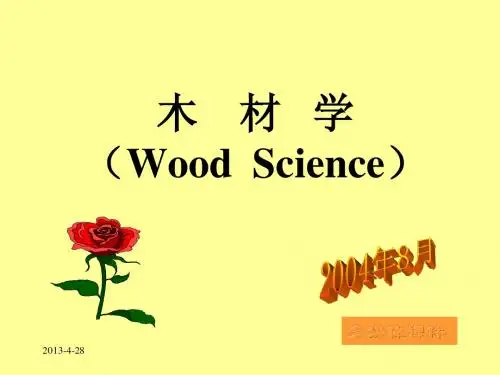
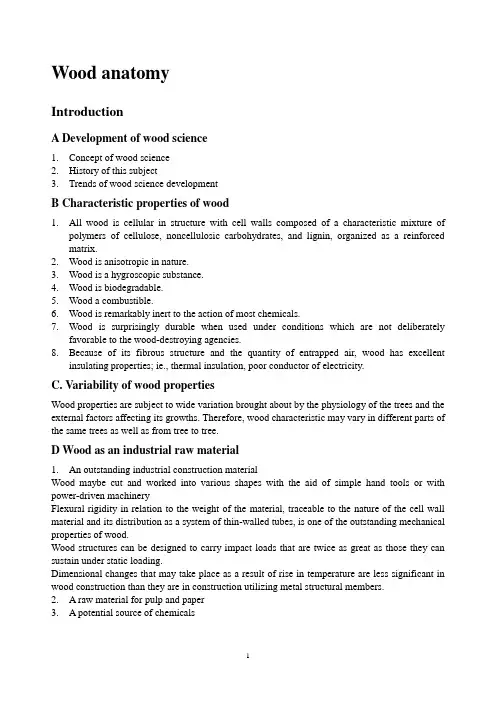
Wood anatomyIntroductionA Development of wood science1.Concept of wood science2.History of this subject3.Trends of wood science developmentB Characteristic properties of wood1.All wood is cellular in structure with cell walls composed of a characteristic mixture ofpolymers of cellulose, noncellulosic carbohydrates, and lignin, organized as a reinforced matrix.2.Wood is anisotropic in nature.3.Wood is a hygroscopic substance.4.Wood is biodegradable.5.Wood a combustible.6.Wood is remarkably inert to the action of most chemicals.7.Wood is surprisingly durable when used under conditions which are not deliberatelyfavorable to the wood-destroying agencies.8.Because of its fibrous structure and the quantity of entrapped air, wood has excellentinsulating properties; ie., thermal insulation, poor conductor of electricity.C. Variability of wood propertiesWood properties are subject to wide variation brought about by the physiology of the trees and the external factors affecting its growths. Therefore, wood characteristic may vary in different parts of the same trees as well as from tree to tree.D Wood as an industrial raw material1.An outstanding industrial construction materialWood maybe cut and worked into various shapes with the aid of simple hand tools or with power-driven machineryFlexural rigidity in relation to the weight of the material, traceable to the nature of the cell wall material and its distribution as a system of thin-walled tubes, is one of the outstanding mechanical properties of wood.Wood structures can be designed to carry impact loads that are twice as great as those they can sustain under static loading.Dimensional changes that may take place as a result of rise in temperature are less significant in wood construction than they are in construction utilizing metal structural members.2. A raw material for pulp and paper3. A potential source of chemicalsE Knowledge of wood and better useCertain characteristics of wood are sometimes cited as detrimental to its use for particular use. But many of these disadvantages, real or implied, could be overcome by intelligent use of wood, based on comprehensive knowledge of its properties.The tree stemI The plant origin of woodWood is of plant origin. The following criteria serve to distinguish woody from nonwoody plants:1.Wood plants must be vascular plants2.They must be perennial plants3.Posses s stem that persists from year to year4.Exhibit secondary thickeningA kinds of woody plantsTrees: at least 20 feetShrubs: seldom exceeds 20 feetWoody lianas: is a climbing woody vineAmong which no hard and fast lines can be drawnB factors controlling the designation of a wood as commercially important1.The size of the tree species producing wood.2.The quality of the wood3.The accessibility and volume of the stands of a given kind of timber4.The status of technological development of consuming industries5.prevailing economic conditions.Lack of adequate transportation of facilities;Because wood of a number of botanically closely related species can not be distinguished with any certainty after a tree is cut and a log converted in to lumberDepend on such considerations as local scarcity of better woods, improvements in manufacture, development of new products, and a better knowledge of technical properties of wood.C softwoods and hardwoodsSoftwoods: conifers, evergreens.Hardwoods: deciduous, broad-leaved trees.Few coniferous species occupy a unique position in the timber economyHardwoods are composed of a large number of tree species with wood of vastly variable characteristics that determine its suitability for specific, diversified uses.II The stemThe body of all vascular consists of a cylindrical axis and appendages.The stem(trunk, bole): limb, branch and branchletThe root(root system): lateral branch root, rootletAppendages: leaves, thorns containing vascular tissue, prickles of rose formed by the outmost layers and hairs arising as extensions of epidermisThe majority subscribe to the idea that flowers are modified forms of shoots or leaves. The central core called the stele is composed of phloem, cambium and xylem (pith , primary xylem and secondary xylem)A formation of the stemThe axis of a tree is formed through the process of elongation and through growth in diameter. Elongation of tree stems is traceable to the primary growth (apical growing points)Growth in diameter is due to the activities of the vascular wood cambium.Several concepts:The plant tissues arising from the apical growing points are called the primary tissuesPlant tissues originating through cell formation in the vascular cambium are known as secondary tissuesA growth ring or annual ring: a single growth increment is formed in a year ( or one growing season). In transverse, it appears as concentric rings, in longitudinal section, it appears as cone-shaped or paraboloid zones.B stem formStem form refers to the taper of the bole from the base to the top of the tree.The basic form is presumed to be genetically controlled and be strongly modified by the environmental influences and cultural practices which affect the vigor, size and shape of the tree crown.The mechanistic and hormonal theories appear to provide the most plausible explanation.1.Mechanistic theories: this theory assumes that the tree stem must be strong enough not onlyto support the weight of the stem and crown of the tree and the additional weight of snow and ice, but also to be able to resist the forces of wind exerted on the crown. As a consequence of these requirements a cylindrical stem would require a higher proportion of denser and stronger late wood in the lower part of the bole than a tapering stem.2.Hormonal theories:Auxin gradient →govern the distribution of radial growth → determine the stem form3The overall of effect of the tree crown on the shape of the stem:Favorable growth condition →long-crowned trees →maximum ring width is formed in the lower part of the trunk. The stem within the crown is generally strongly tapered because of the downward increase in the number and cumulative effect of branches on formatin of wood in the upper stem.C Gross characteristics of the stem wood1 growth incrementsa/ Early wood (Spring wood): The portion formed in the early part of the growing season has larger cells and is relatively low in density.Late wood (Summer wood): The denser and usually darker-colored wood formed in the last part of growing season.Transition between the early and late wood maybe:Abrupt transition: hard pines, ring-porousGradual transition: soft pines, diffuse-porous.b/Variation in width of growth incrementsFast-growing species: poplar (Populus spp.), Slashpine (Pinus elliottii Engelm.)Shade-tolerant speciesLight-demanding speciesSite effect: better-drained sites, Swamps, dry limestone outcropsc/ Discontinuous and false ringsIn very old or suppressed trees, some of the growth increments may be interrupted.Discontinuous rings: The growth increments do not completely surround the stem but are present only in part of it.False ring: False rings are wholly included within the boundaries of true rings. A band of what appears to be late wood is formed which simulates normal late wood in appearance and density; this is followed by tissue resembling early wood, after which true late wood is producedDouble rings: If only one false ring is included in the true rings, the latter is designated as a double rings;Multiple rings: If more than one of such false rings occur within the boundaries of the true ring, the latter is said to be a multiple ring.2 Planes of reference in the stemTransverse surfaces (x): Cross sectionRadial surface (r)Tangential surface (t)3 Sapwood and heartwoodThat part of the woody core in the tree in which some xylem cells are living and hence physiologically active is called sapwood.Secondary changes that take place as a result of death of the protoplasm of the living cells in the xylem lead to formation of a physiologically dead part of the xylem, called heartwood Intermediate zone: between the sapwood and the heartwooda/ Classify all trees on the basis of distinctiveness of heartwood ;Sapwood trees (Alnus spp)Ripewood trees (Abies spp)Trees with regularly formed heartwood (exs. Oak, walnut, cherry)Trees with irregular heartwood (ex. Fraxinus spp)b/ Bosshard’s Classification of heartwood formationTrees with retarded formation of heartwoodTrees with light heartwoodTrees with obligatory colored heartwoodTrees with facultatively colored heartwoodc/There are two hypotheses of heartwood formationThe older advocates that heartwood formation of air in the closed cell system → this brings about secondary changes in the protoplasm of the parenchyma cells → leading to formation if extraneous substances and causing the death of the parenchyma cells.Rudman’s hypotheses,In late summer, height growth terminates and cambium growth slows → large crown function continue →sugars is likely to exceed the tree’s needs (unneeded sugars move inward by bark ray and unneeded sugars begin to accumulate near the center of stem) → converted into new compounds, decomposition of sugars →leads to formation of various polyphenolic compounds → other food material concentration → kill cells → heartwood formation.d/ Extractive substance is formed while heartwood formationHeartwood is often more durable; reduces the permeability of the heartwood; heartwood is somewhat heavier than sapwood at the same moisture content.Interfere with bleaching of the pulp; is more beautiful.e/ The width of the sapwood expressed as a linear measure or in terms of numbers of growth increments varies in different trees of the same species and at different heights in the same tree. The tree requires a fairly constant volume of sapwood at all levels in the stem; on geometrical considerations it is evident that the sapwood shell in a tree can decrease in width as the tree diameter increases, and still maintain a constant cross-sectional area.f/ wound heartwood: the abnormal tissue of the heartwood, which was caused by wounding of the tree.False heartwood: often forms in trees which do not normally have colored heartwood. False heartwood is known to occur in beech, birch, maple, poplar, aspen, and pine4 Color in woodcolor in wood is due mainly to extractives or may also contribute to the color of exposed wood surface thought oxidation.In general, color of sapwood, it may be gray or pale shade of yellow, white, pink, or red. Color of heartwood, it striking or unusual enough, can be important in identification of wood; it may also be responsible for perferential uses, but precise description of wood color is seldom possible, which must be supplemented with other structural criteria. Measurement of color is obtained with spectrophotometer.Russel effect: A photographic image of a varying degree of intensity for heartwood and sapwood is obtained when a photographic film is placed in contact with a wood specimen and then developed in the usual manner.5 Luster (sheen)Luster is the property of wood that enables it to reflect light, in other words, the property of exhibiting sheen.6 Odor and tasteA number of woods have a distinctive odor, which may be caused by inflitration products in the heartwood or by the action of fungi, bacteria, or molds.7 Grain and textureGrain refers to the longitudinal alignment of cells. It can be determined by the type of cleavage produced when wood is split.Grain includes straight grain, cross-grained, curly or wavy-grained, spiral grain, interlocked grain.Texture refers to the relative differences in appearance of the growth increments in the size, and kinds of cells between early and late wood.Coarse texture: large, open elements in ring-porous hardwood or large lumen from uniformly distribution cells.Even texture: even medium-textured8 WeightThe weight of wood varies according to:Amount of wood substance present per unit volume;The amount of infiltration;Moisture contents.9 HardnessHardness is a useful indicator of its physical characteristics.In general, it can be roughly tested with a knife and thumbnail.10 Anatomical features of wood of importance in identification.a/ According to the size and distribution of vessels or pores in early wood and late wood, the hardwood can be designated as:Ring-porous: The vessels in the early wood are much larger than those in the late wood of the same growth ring. The transition from one size of pores to another may be quite abrupt; such woods then are described as ring-porous. Ex., oak,Diffuse-porous: When transition in size of pores from the early to late wood is gradual, or when the pores do not appreciably vary in size throughout the ring, the woods are said to be diffuse-porous. Ex., birch, poplar, mapleSemi-ring porous: wood with the pore transition between ring-porous and diffuse-porous.b/ resin canals: are tubular intercellular spaces surrounded by secreting cells,mainly formed in pines, spruces, larch and tamarack, doughlas-firit appears as small openings or white spots in the transverse section and inconspicuous in longitudinal sectionc/ rayOn the transverse section: lines of varying widthOn the radial section: flecksIn the tangential plane: short staggered linesd/ wood parenchymaray parenchyma: constitute the bulk of ray tissue.Epithelial parenchymaAxial or longitudinal parenchyma: it may be massed in lines or in bands running along the growth ring or may encircle the pores, making them appear thick-walled on transverse section. It is an important feature in identification of woods with a hand lens.11 Figure in wooda/ Growth increments and figure in woodPlain, flat-saw lumber: it consists of nested, angular parabolic, irregularly concentric patterns Flat-cut veneerQuartered veneer: veneer produced by radial slicing or sawing. It is also called edge-grained or vertical-grained and is often used for flooring because of the more even wearing quality and the reduced transverse shrinkage.sewQuarter-sewn: in Oak, it called rift-sawn. Lumber in which growth rings from an angle of 45 or more with the wide surface of the board is classified commercially.Half-round veneerBack-cut veneer,Cone-cutting: as pencil cuttingb/ Figure caused by grain orientation in woodRibbon or stripe figure caused by interlocked grainCurly or wavy-grain figrueBroken stripeBlister and quilted figrueBird’s eye and dimplesCrotch and stump figuresBurl figuresc/ figure caused by color distributionIII BarkEpidermisPeriderm consists of three layers: the phellogen, the phellem and the phellodermThe number of successive periderms persisting outside the living bark is variable and is not necessarily indicative of the thickness of the dead bark.The bark on a mature tree is formed through the activity of the vascular cambium and the bark cambium, it is never so thick as the wood. There are three reasons for this:1 the layer of xylem formed during a given year usually consists of many rows of cells and therefore is much thicker and the corresponding layer of phloem2 The old phloem tissue is compressed radially and hence no longer occupies so much space as formerly.3 outside layers of bark formed in the later years consist of old phloem tissues; the yare shed from time to time through the process of periderm formation already described.Uses of barkBottle of stopper frp, cork oakTanning leatherBroken or shredded bark are s fuel, insulation, mulching for plants, soil conditioner, animal bedding, packing material, oil-spill absorbent, and plastic and adhesive fillers and for heavy metal ion scavenging and filtering.Also extracted as a source of oil-well drilling mud additives and as a source of waxes.Origin and development of woody cellsAll plants are composed of basic structural and physiological units called cells.Aggregations of the secondary xylem wood cells of similar type or with similar function are knows as tissues.I Apical meristemThe elongation of tree stems (branches and roots) is traceable to primary meristems (apical meristem and growing).Schematic drawing portraying the ontogeny of young tree stem (figure 2-3)II Vascular cambiumA Cell organization in the vascular cambiumThe vascular cambium is composed of fusiform initials and cambial ray initials.the fusiform initials,In conifers, length < 2000um to 9000um; diameter > 30 umIn primitive hardwood, length is 1000um to 2000umIn highly developed hardwoods, length is 300um to 600umB The process of cell division in the vascular cambiumMitosis:C Formation of new cambial initialsCambial initials devide in two ways.PeridinallyPseudotransversely or anticlinallyCause of increase in the circumference of the vascular cambium:The formation of new cambial initials of call types;Increase in length of the fusiform initials;Increase in tangential diameter;Number of fusiform initials in life form 724 to 23100 and the ray initials form 70 to 87961/ Formation of new fusiform initialsstratified cambialThe survival of the newly formed fusiform initials in depends largely on the length of the new initial and the extent of contact with the rays.2/ Formation of ray initials in the vascular cambiumthrough reduction of short fusiform initials to a single ray cell;by separation of the entire such initial into a number of ray cells;formed at the side of a fusiform initial or arise by pinching of the tips of the fusiform initials. Ways of multiseriate rays:✧By addition of more ray initials at the side of the existing initials.✧By division of ray initials themselves✧By fusion of two or more proximate rays3/ Variations in length of fusiform initialsThe variations in the average length of fusiform initials are reflected in corresponding differences in length of the derived xylem cells.a/ variation in length in the radial direction .A negative correlation that exists between the frequency of pseudotransverse division of the cambial initials and the length of the newly formed initials;The extent of preferential loss of shorter, less-efficient fusiform cambial initials by transformation into ray initials or by direct maturation into xylem and phloem cells without further subdivision.b/ Variation along the length of the tree trunkc/ Effect of growth rate on length of cambial initialsD Formation of new xylem and phloem cellsSee figure 2-16E Seasonal activity of the vascular cambiumIII Postcambial xylem cell enlargementMany types of cells increase in their overall dimensions before maturation.The enlargement can be arbitrarily divided into increase in diameter and elongation of the developing cell.In the softwoods, diameter increase is almost entirely in the radial direction, and almost no tangential enlargement takes place.In hardwoods, the vessel elements in early wood of ring-porous woods, exhibit a major increase in tangential diameters, followed by that in the radial direction.Intrusive growth:The Woody cell wallI Chemical components of the plant cell wallSee table 3-1A Polysaccharide fractions of the cell wall(holocellulose)1 cellulose2 hemicelluloseB LigninLignin is formed only in the walls of living plants in the spermatophytes, the pteridophytes, and the mosses.C Secondary cell wall components1 Extraneous materials2 Ash contentD Analytical dataII Basic structure of the woody cell wallA Microfibrillar organizationMicrofibrils: the polysaccharides in woody plant cell walls are physically aggregated into very long strands.Crystallites: the crystalline core of the microfibril can be broken by the action of chemicals into units.B Aggregations of microfibrilsReinforced theory: These microfibrils consist of a core of crystalline cellulose surrounded by short-chain hemicelluloses that are partly linked to the cellulose core. Deposition of lignin and extractives, after the microfibrils are formed, encases them and binds them into a rigid structure, living a network of microcapillary voids which allow water to penetrate into the cell walls.C Density of the cell wallD Summary of organization of cell wall materialsIII The primary cell wallMultinet theoryMcirotubuleAppositionPlasmodesmataIV The normal secondary cell wallA Secondary-wall structure of tracheids and fibersSee figure 3-5, 3-6Pr, S1, S2, S3, WB Wall structure of xylem parenchyma cellsThe major difference in cell wall structure between parenchyma cells and those in tracheids and fibers is that parenchyma, cells posses special wall organization called protective layers.C Distribution of chemical constituents in the cell wallSee figure 3-10V Modification of the cell wallA pitting of the cell wallA pit is defined as a recess in the secondary wall of the cell , open to the lumen on one side and including the membrane closing the recess on the other side.Pit aperture (included, extended)Pit chamberPit borderPit torus(turi)MargoA pit pairComplementary pitsBlind pitsPit cavityPit membraneCell lumenA simple pitBordered pit parsA half-bordered pit pairLinear pittingScalariform pittingOpposite pittingAlternate pittingTwo other mechanisms for reduction of flow through bordered pits of conifers have been proposed in addition to pit aspiration:1/ Occlusion of the pit membrane with heartwood extractives;e.g., extraction of incense cedar wood with ethanol can increase permeability of the heartwood as much as 10,000 times;2/ incrustation of the pit membrane with insoluble lignin-like materialsB perforation of the cell wallSimple perforation plateMultiple perforation plateScalariform perforation plateBarsC Thickenings of the cell wall1 Spiral thickingsspiral thickings are ridges of microfibrils which form on the surface of the S3 layer in varying degrees of prominence2 DentationsD Wart structures and vestured pitting1 warts2 vestured pittingin the angiosperms a development of the warty structure into large simple or branched forms associated with the pits is knows as vestured pittingVI Special forms of cell wallsA Septa(septum)B TylosesVII intercellular spacesThe minute structure of coniferous woods (Softwoods)Table 4-1 illustrate the types of cells (elements) in Coniferous woodsI Longitudinal coniferous tracheidsA Tracheid volume90 to 94 percentB Arrangement and shape of tracheids with growth ringsAbrupt transition in diameter and wall thickness between early and late wood (hard pines)The tangential diameter of longitudinal tracheids remains quite constant within the growth ring or with the age of tree.C Size of longitudianal tracheidsLarge > 3.0 – 5.0Short <3.0Average 3.0- 5.0D Marking of longitudinal tracheidsPitsSpiral thickenTrabeculaeCallitrisoid1 pitsa/ intertrachealb/ those betweeen the longitudinal tracheid and ray parenchymac/ those between the longitudinal tracheid and ray tracheids.Bars of sanio or crassulaeFigure 4-4Crassulae are confined to the radial walls of tracheids2 spiral thickenings on the wall of longitudinal tracheids3 callitresoid4trabeculae: due to fungal hypha5longitudinal resinous tracheidsE Longitudinal strand tracheidsLongitudinal strand tracheids may be regarded as transitional elements between longitudinaltracheids and epithelial or longitudinal parenchymaII Parenchyma in coniferous woodsA Longitudinal ( axial) parenchymaParenchyma usually appears as a strand thinner-walled than neighboring tracheids and frequently contains extraneous materialsDiffuseBandedTerminalMarginalB Ray parenchymaC Epithelial parenchyma and resin canalsThe resin canal as such is therefore not a wood element but a cavity surrounded by thin walled, parenchymatous cells ( epithelial cells)1 Formation of resin canalsAn intercellular cavityNormal resin canalsTraumatic2 Normal resin canalsThe resin canal occurs in pinus, Picea, Larix and Pseudotsuga3 Traumatic resin canalsThey are much larger than the normal canalsIII Transversely oriented cellsA Types of transverse cells in softwoodsRay parenchymaRay tracheidsEpithelial cellsa/ Ray parenchymaCross fields: the common-wall areas between cells of the ray parenchyma and the longitudinal tracheids. (Shape, size and arrangement are different)Window-like ( fenestriform) ( soft pine)Pinoid pits (hard Pine)Piceoid pits (picea, larix and pseudotsuga)Taxodioid pitsCupressoid pits2 ray tracheidsdentate thicknessthe inner wall of ray tracheids in hard pines possesses irregular tooth like projections or reticulatedthe har d pines with dentate ray tracheids also have ―warts‖B Rays in softwoods1 rays without resin canals (uniseriate rays)homocellularheterocellular2 fusiform raysfusiform rays, so-called because of their spinkle- like shapefusiform rays occur in four genera of the pinaceace: Pinus, Picea, Larix and Pseudotsuga.IV Crystalliferous wood elements in softwoodsCrystal-bearing cells are apparently restricted to the pinaceae ( in Abies)Ray tracheidsEpithelial cellsThe minute structure of hardwoodsDistinguished features between coniferous woods and hardwoods:a/ hardwoods possess vessel elements( porous woods, nonporous woods)b/The radial alignment of the longitudinal cells is wanting or more or less obscured in hardwoods because of vessel enlargement and vessel element failing to divide.c/hardwood are much more complex in structure than softwoods because more cells enter in to their composition.d/ the rays of hardwoods are more variable in width than those of conifers.I Development of the elements of porous woods from cambial initialsFigure 5-3 serves to emphasize the fact that the longitudinal elements of wood are all derived from the same type of cambial initial.The way of differentiation of the various types of cells derived from the fusiform initials in the cambium proceeds along three principal lines;1 Elongation2 Increase in daimeter3 Division into a vertical row of cells by means of transverse walls.II Comparative anatomy of the hardwoodsA Longitudinal elements1 vessel elements2 trachiedsa vasicentric tracheidsb vascular tracheids3 fibersa fiber tracheidsb libriform fibers4 longitudinal (axial) parenchymaa cells of axial (strand) parenchymab fusiform parenchyma cellsc epithelial cells; excreting cells encircling the cavities of longitudinal gum canalsB Transverse elements1 cells of ray parenchymaa procumbent or upright ray cell exclusively—homocellular raysb procumbent and upright ray cells – heterocellular rays2 epithelial cells; excreting cells encircling the cavities of transverse gum canalsA Longitudinal elements of porous woods1 vessel elementsvessels do not exist in isolation, but, in fact, numerous areas of communication exist between vessels over their surfaces.a formation of component vessel elementsFusiform cambial initial—enlarges transverselyb shape of size of vessel elementsFigure 5-4c arrangement of vessel elementsRing porousDiffuse porousSemi-ring-porousSolitary porePore multipled sculpturing of vessel elements1/ nature of the opening between vessel elementsperforation plateperforation (simple, scalariform, reticulate)2/ Nature and extent of pitting on he walls of vessel elementspit pairs: bordered , half-bordered and simple pit pairsalternate pittingopposite pittingscalariform pittingvestural pit3/ Spiral thickening in vessel elementse Inclusions in vessel elementstylosis and various amorphous exudiations that are gummy, resinous, or chalky in nature. Raraly, starch grains and crystals are also in evidence.f trabeculae in vessel elementsg vessel volume2 trachiedsa vasicentric tracheids: contain numerous bordered pits, pisses conspicuous spiral thickenings.b vascular tracheidsvesicentric tracheids differ from vascular tracheids in having tapering or around ends and in not being arranged in define longitudinal raws.。
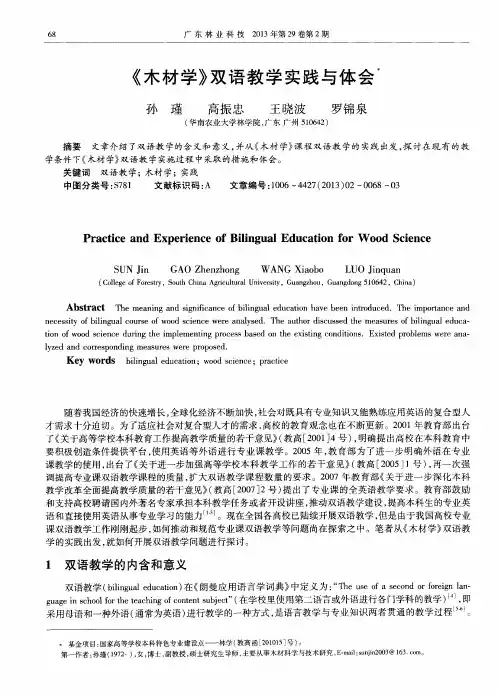
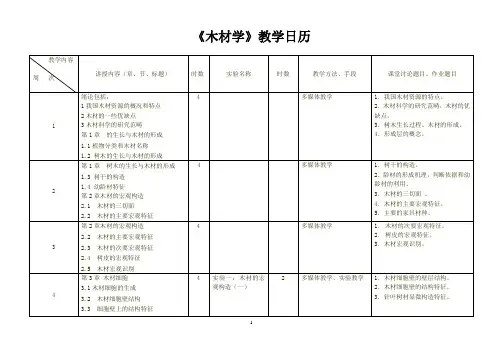
14《木材》教学设计一.教学目标:1.知识目标:(1)知道木材是天然材料,了解木材的性能及用途。
(2)能针对探究木材的特点提出观察实验的大致思路,并能根据自己的设计进行观察实验。
(3)知道探究不同的问题要用不同的探究方法。
2.能力目标:(4)能对研究过程和结果进行评议,并与他人交换意见。
3.情感目标:(5)在探究木材特点的观察实验活动中体验合作与交流,尊重他人的观察实验结果。
(6)意识到不合理使用木材会给人类与社会发展带来负面影响。
二.教学重难点:1.探究木材的特点实验方案的设计,知道探究不同的问题要用不同的探究方法。
2.知道木材是天然材料,了解木材的性能及用途。
三.教学准备:1.搜集有关木才的资料或图片。
2. 制作课件。
3.准备实验器材:常见木头若干如:杨木、柳木、榆木、梧桐木、槐木等;酒精灯;火柴;放大镜;锤子;小刀;水槽;电池;导线;小灯泡等。
四.教学方法:探究发现法、实验探索法、小组讨论法。
五.教学过程:1.欣赏视频,引入新课播放视频《森林的早晨》,让学生欣赏。
然后引导学生:今天所研究的内容与欣赏的视频有关,然后让学生猜,从而引入课题。
【目的是通过视频,将学生的注意力很快吸引到课堂上来,然后通过教师的引导,激发学生探究的欲望和兴趣。
】2.合作探究,木材的特点本环节的探究流程是:提出问题→进行猜想与假设→制定实验方案→合作探究→展示交流,得出结论。
(1)提出问题。
启发学生:同学们,你想研究木材哪些方面的问题?在肯定学生大胆提出有关问题的基础上,出示本课要重点研究的问题:(投影)1.木材有没有花纹(年轮)?2.木材能不能燃烧?3.木材在水中是浮还是沉?4.木材导热能力怎样?5.木材的软硬程度?6.木材能不能导电?【目的是培养学生从日常生活、自然现象和学习过程中发现问题习惯。
“发明千千万,起点是一问。
”说的就是提出问题的重要性。
】(2)进行猜想与假设。
教师引导:在研究之前先请同学们猜一猜它们是怎样的?学生猜测。
绶全国中小学Ik材审定类员会2002年初审通过义务教育课程标准实脸教科15YUWEN三年级上册《给予树》♦教材分析I /课文写的是在圣诞节到来之前,小女儿金吉娅把应该给家人买礼物的钱买了一个洋娃娃,送给了一个素不相识的需要帮助的女孩。
课文赞扬了金吉娅的爱心和她的善良品质。
圣诞节是西方最重要的节日,这是一个爱意流动的日子。
在这样的一个特殊节日里,一个小女孩渴望拥有一个洋娃娃的愿望,另一个素不相识的小女孩金吉娅帮她实现了,这是一个多么美丽的故事。
金吉娅小小的年纪,却能够将心比心,设身处地为他人着想,从中可以看到她金子般的心灵。
课文从妈妈''我”的角度来叙述故事,通过“我”的观察、心理变化及行为来体现金吉娅的善良品质。
特别是通过孩子的做法和“我”开始对金吉娅的误解,衬托了金吉娅的美好心灵。
选编这篇课文的意图:一是体会金吉娅的善良和富有同情心,并从中受到感染和熏陶; 二是继续学习体会课文中人物思想感情的训练要点,积累语言。
本课的教学重点是通过妈妈感情的变化,体会金吉娅善良、富有同情心的美好品质,难点是理解课文的最后一段话。
♦教学目标【知识与能力目标】认识生字,理解课文中的词语意思。
【过程与方法目标】通过学生自主学习,体会人物内心;合作探究,懂得爱就在我们身边,每个人都能献出自己的爱。
【情感态度价值观目标】体会到金吉娅的善良和富有同情心,培养关爱他人的感情。
♦教学重难点【教学重点】通过妈妈感情的变化,体会金吉娅善良、富有同情心的美好品质。
♦课前准备多媒体课件♦教学过程第一课时一、学习第一自然段,谈话导入课题。
1、师:同学们知道圣诞节吗?猜猜12月25日是什么节日?出示新词:圣诞节每年的12月25日是圣诞节。
这是西方国家最重要的节日,相当于中国的春节。
圣诞节的庆祝活动从12月24日晚上的圣诞夜开始,一直持续到第二年的1月6日。
在圣诞夜,人们围着圣诞树唱歌跳舞,还有人穿上红衣服,戴上白胡子,扮成圣诞老人,给孩子们分发礼物。
《树木学》教案课程类别:C课程代码:04开课专业: 林学任课老师:覃家理开课时间:一年级第二学期总学时:48 (其中,讲课:32 实验:16)使用教材: 《树木学》(南方本)第一版或第二版教案说明: 本教案内容以90分钟(2学时)为一单元, 配合与课件教材使用讲课学时: 32,实验学时16学分:2.5实践教学:1.0周一、教学方案总设计体树木学是林学专业的专业基础课, 通过学习本课程和相应的实践课,要求学生掌握有关树木分类的基本概念、种类识别的工具、主要植物类群及其代表植物,对那些在科学研究、经济利用、生态及自然保护等方面具有重要价值的种类要求重点掌握,尤其是构成我国主要地带性森林植被的种类。
应重点掌握的科有:苏铁科、银杏科、松科、杉科、柏科、红豆杉科、木兰科、八角科、樟科、蔷薇科、豆科(包括苏木科、含羞草科、蝶形花科)、蓝果树科、杨柳科、壳斗科、桦木科、胡桃科、桑科、大戟科、山茶科、龙脑香科、杜鹃花科、越桔科、桃金娘科、芸香科、无患子科、漆树科、槭科、木犀科、紫葳科、棕榈科、禾本科之竹亚科。
要求熟悉或一般性了解的科:罗汉松科、三尖杉科、山茱萸科、五加科、忍冬科、金缕梅科、山龙眼科、鼠李科、鼠李科、卫矛科、冬青科、野牡丹科、楝科、茜草科、紫葳科、马鞭草科、玄参科。
二、教案文本单元11、教学内容:课程要求、学习方法、绪论2、教学目的(1)让学生了解课程的性质、基本要求、学习方法,了解该课程的作用和重要性,以及与其它课程的关系;(2)树木分类的基本知识3、教学重点及难点(1)物种的概念(2)分类方法、分类的主要和次要等级(3)植物命名4、授课方法及手段:利用多媒体进行课堂讲授5、讲课具体内容(1)《树木学》课堂学习要求(2)《树木学》课程的学习方法(3)《树木学》的作用及其与其它课程的关系(4)基本概念:树木、树木学、种、学名、双名法、属、种加词、分类、自然分类、人为分类、分类等级(5)分类的主要和次要等级6、作业及思考题(1)复习《植物学》中学习过的树木分类有关的主要形态术语(2)预习植物分类系统、分类依据、检索表、树木分布区、裸子植物门、苏铁科、银杏科单元21、教学内容:分类系统、检索表、裸子植物门、苏铁科2、教学目的(1)让学生了解树木分类的系统;(2)了解检索表的类型、结构特点和使用方法(3)介绍裸子植物门、苏铁科、银杏科植物的特征及代表植物3、教学重点及难点(1)哈钦松系统、恩革勒系统(2)检索表的编制原理和使用方法(3)裸子植物门的特征4、授课方法及手段:利用多媒体进行课堂讲授5、讲课具体内容(1)基本概念:分类系统、种群、生态型、分布区、植物区系、特有种、检索表、定距检索表、平行检索表、球花、球果、孢子叶、孢子叶球、苞鳞、种鳞、珠鳞、鳞盾、鳞脐(2)树木分类的主要依据(3)树木分布区的类型及其形成(4)植物分类系统类型及其理论基础(5)植物检索表的类型、结构及使用方法(6)裸子植物门的特征及分布特点(7)苏铁科特征及代表植物6、作业及思考题(1)预习内容:银杏科、松科、杉科、柏科(2)教材内容编排采用什么分类系统?其主要特征是什么?(3)裸子植物门具有什么特征?你知道哪些植物属于裸子植物?(4)苏铁科有什么特征?在校园内有哪些代表植物?(5)树木的分布区是如何形成的?影响树木分布区形成的因素有哪些?(6)树木的分布区有哪些类型?单元31、教学内容:裸子植物分类之银杏科、松科2、教学目的松科是裸子植物种类最多、分布最广的一个科,通过本节课的学习,学生应掌握:(1)银杏科特征(2)松科的特征及其主要代表类群(3)松科主要属的特征及其代表植物(4)松科植物在自然分布上的特点3、教学重点及难点(1)银杏科特征(2)松科的特征(3)松科主要属的特征及代表植物4、授课方法及手段:利用多媒体进行课堂讲授5、讲课具体内容(1)银杏科特征及代表植物(2)松科特征及其分布特点(3)松科代表属:云杉属、银杉属、雪松属、云杉属、冷杉属、油杉属、铁杉属、黄杉属、落叶松属、松属的特征及代表植物6、作业及思考题(1)银杏科具有独特的特征?(2)松科具有哪些特征?(3)云杉属、冷杉属和油杉属具有哪些主要区别特征?(4)松属植物可以划分为哪些类群?(5)松科植物具有哪些重要价值?(6)松科不同的属地理分布有什么特点单元41、教学内容:裸子植物分类之杉科、柏科2、教学目的(1)识别杉科特征及其主要代表类群(2)识别柏科的特征及主要其代表类群3、教学重点及难点(1)杉科、柏科特征(2)松科、杉科、柏科之间的区别及演化趋势(3)杉科、柏科主要属的特征及代表植物4、授课方法及手段:利用多媒体进行课堂讲授5、讲课具体内容(1)杉科特征及其分布特点(2)杉科代表属:水杉属、杉木属、柳杉属、台湾杉属特征及其代表植物(3)柏科特征及其分布特点(4)柏科代表属:侧柏属、柏木属、福建柏属、翠柏属、圆柏属、刺柏属的特征及代表植物6、作业及思考题(1)松科、杉科、柏科具有哪些特征?它们在演化上的趋势是什么?(2)柳杉属和台湾杉属有什么重要区别?(3)侧柏属、翠柏属和福建柏属具有什么类似特征?它们的区别在哪里?(4)圆柏属和刺柏属有哪些共同特征和重要区别?单元51、教学内容:裸子植物分类之罗汉松科、三尖杉科、红豆杉科2、教学目的(1)识别罗汉松科及其代表植物(2)识别三尖杉科及其代表植物(3)识别红豆杉科及其代表植物3、教学重点及难点(1)罗汉松科、三尖杉科、红豆杉科的特征及其区别4、授课方法及手段:利用多媒体进行课堂讲授5、讲课具体内容(1)罗汉松科特征及分布(2)罗汉松属特征及代表植物(3)三尖杉科特征及分布(4)三尖杉属特征及代表植物(5)红豆杉科特征及分布(6)红豆杉属、榧树属的特征及代表植物6、作业及思考题(1)罗汉松科、三尖杉科、红豆杉科的特征是什么?它们之间具有哪些重要区别和共同点?(2)罗汉松属植物有什么应用价值?(3)三尖杉属和红豆杉属植物在医药上有什么价值?单元61、教学内容:被子植物分类形态学基础(1)——根、茎、叶形态特征2、教学目的根、茎、叶是植物分类的重要特征,本节课程的学习让学生:(1)了解根与植物分类有关的术语及其含义(2)了解叶与植物分类有关的术语及其含义(3)了解茎与植物分类有关的术语及其含义3、教学重点及难点(1)叶的类型及形态特征(2)茎和枝条的形态特征(3)根、茎、叶的变态类型及其在分类上的作用4、授课方法及手段:利用多媒体进行课堂讲授5、讲课具体内容(1)根系类型:直根系、须根系(2)根的变态:肉质直根、块根、支柱根、呼吸根、气生根、攀缘根、寄生根(3)枝条的形态特征(4)芽的类型(5)茎的习性类型及分枝方式(6)茎的变态类型:地上茎、地下茎(7)叶的基本结构(8)叶脉的类型(9)叶的着生方式(10)叶片的形态(11)叶的类型(12)叶的变态类型6、作业及思考题(1)什么是枝条?它具有哪些基本形态特征?(2)茎具有哪些分枝方式?它们分别出现在哪些主要植物类群中?(3)茎有哪些变态类型?每种类型有哪些代表植物?(4)如何区别羽状脉和掌状脉?(5)如何区别单叶和复叶?(6)复叶的“回”是什么含义?在实践中如何区分一回、二回、三回及多回羽状复叶(7)如何区别叶刺、茎刺和皮刺?(8)复叶具有哪些类型?每种类型试列举1-2种代表植物。